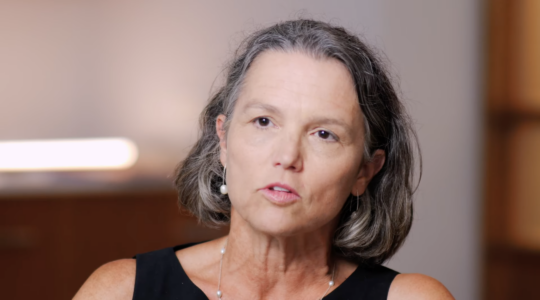(This is part of a special JTA report on conversion in America. Read our other pieces about the denomination-by-denomination breakdown of how the different religious streams do conversion, and 10 questions about conversion to Judaism you want to know but are afraid to ask.)

Mayyim Hayyim, a nondenominational mikvah in Newton, Mass., has been the site of some 2,200 conversion immersions since it opened in 2004. (Tom Kates)
NEW YORK (JTA) – Dear Friend,
I understand you’re considering converting to Judaism. Shalom aleichem!
What sort of conversion would you like?
If Orthodox, the answer is no, no, no. Tradition dictates that prospective converts be rebuffed three times as a test of their true commitment.
For a more welcoming denomination, try Reform Judaism. In 1978, then-movement leader Rabbi Alexander Schindler called for discontinuing the custom of rejection and instead responding “openly and positively to those God-seekers whose search leads them to our door.”
This summer — 36 years later — the Conservative movement followed suit.
“Tradition has often not done much to encourage it. That must change,” Arnold Eisen, the chancellor of the movement’s Jewish Theological Seminary, wrote of conversion in a Wall Street Journal column in July. “Why? Because Judaism needs more Jews, and has a lot to offer them.”
Are Americans finding the call to Judaism appealing? We have no idea. None of the major Jewish denominations keeps comprehensive records on converts.
About 200 Orthodox converts per year are certified by the Rabbinical Council of America, but not all Orthodox conversions go through the RCA system. Likewise, the Reform movement’s collection of conversion certificates at the American Jewish Archives in Cincinnati — about 800-900 are added per year — is purely voluntary and not limited to Reform converts.
There is some survey data, however. The Pew Research Center’s 2013 poll of 3,475 American Jews counted 52 converts — 1.6 percent of respondents, according to data analysis conducted by Prof. Steven M. Cohen of Hebrew Union College-Jewish Institute of Religion. Fifty-four percent of those converts identified as Reform, 27 percent as Conservative and 8.5 percent as Orthodox.
A 2011 community survey by UJA-Federation of New York found that fewer than 2 percent of interviewees identified as converts. Yet more than 5 percent said they were born outside the faith but considered themselves Jewish despite not having formally converted.
But quality is more important than quantity anyway, no?
So why are you converting? Is it for the argumentation? The jokes? Our secret gefilte fish recipe?
If it’s because you’re in love with a Jew, you’re in good company. Up to one-third of Orthodox converts and two-thirds of Conservative converts choose Judaism for this reason, according to rabbis involved in conversion programs. Conversion may be unnecessary if you’re open to a Reform wedding: Reform Judaism permits interfaith marriages, though roughly half of all Reform rabbis still abjure officiating at them.

Missy Jane, center, reads her declaration of faith as she converts to Judaism during a ceremony at the Academy for Jewish Religion, May 9, 2014. (Adam Greenwald)
Many non-Jews become “Jews by choice” because they’re spiritual seekers. Others are already involved in a Jewish community. Especially in the Reform movement, many converts are longtime community members who formally join the faith only after years spent married to a Jew, raising children as Jews and attending synagogue.
That doesn’t mean newbies aren’t welcome, of course. After 14 weeks or so in a Reform Introduction to Judaism course, you may be invited to join the Jewish people — even if you don’t yet feel fully Jewish.
“A more traditional approach to conversion might say you go through a period of study, you get tested and then you’re ready to convert,” said Rabbi Josh Bennett of Temple Israel in West Bloomfield, Mich., the largest Reform synagogue in the United States. “The Reform movement at Temple Israel argues that conversion is somewhere in the middle of the process.”
Just make sure you’re committed: Once you convert, there’s no going back (according to most opinions).
You can, however, go for more. In fact, a substantial proportion of Orthodox converts are one-time Reform and Conservative converts who want the imprimatur of an Orthodox conversion, or individuals raised as Jews who subsequently realized they didn’t qualify as Jewish according to traditional Jewish law, or halachah.
Ready to join? You’ll have to go before a three-judge religious panel called a beit din, declare your fidelity to the faith and probably take a dip in the mikvah — required by Orthodox and Conservative, encouraged by Reform.
Oh, and there’s the little matter of your foreskin. If you’re an uncircumcised male, you’re going to have to get rid of it — at least if you’re converting Orthodox or Conservative. If you’re already medically circumcised, they’ll make do with a symbolical drawing of blood from your place of circumcision, a ritual called called hatafat dam brit.
Ready to move on to some of conversion’s benefits? I thought so.
For one thing, you can have a Conservative or Orthodox wedding (assuming you get the corresponding conversion). Membership in the tribe also entitles you to Israeli citizenship. But beware: Depending on who converted you, you may be subject to some restrictions in Israel.

Students participate in a class at the Miller Introduction to Judaism program at American Jewish University in Los Angeles. (Karen Holdych Harley Photography)
The Orthodox-controlled Chief Rabbinate in Israel does not recognize non-Orthodox conversions, so you won’t be able to marry a Jew there if you converted Conservative or Reform. Orthodox converts must prove their Jewish bona fides, and the Chief Rabbinate has been known to look suspiciously even on some rabbis affiliated with the Rabbinical Council of America.
Still interested? I hope you’re not in too much of a rush. Like a good brisket, conversion takes time.
Both the Conservative and Reform movements offer Introduction to Judaism classes throughout the United States that meet for about three hours weekly over the course of 14 to 18 weeks.
Adam Greenwald, a Conservative rabbi and director of the Miller Introduction to Judaism program at American Jewish University in Los Angeles, says he encourages prospective converts to have at least three months of “active Jewish living” before they take the plunge. Don’t worry: That doesn’t mean you have to commit to observing Conservative Judaism in all its facets.
“What I tell people is, in order to convert they need to be engaging with all of the areas of Jewish life,” Greenwald said. “If they say ‘this is how I currently reflect my Jewish commitments in my diet,’ and there’s some intentionality around it, that’s sufficient for our purposes.”
Orthodox conversion requires commitment to all of the Torah’s 613 commandments and the minutia of rabbinic law, so expect to spend a year or more studying with a rabbi or religious mentor.
“There has to be a sense there’s a fluency for how to live life as an observant Jew — Shabbos, kashrut, lifecycle, family purity, basic concepts of Jewish philosophy and history,” said Rabbi Mark Dratch, executive vice president of the Rabbinical Council of America. “There’s no expectation that a potential convert will know everything. That’s more than a lifetime challenge.”
Once you do convert, remember: You’re in good company. You’ll be joining the patriarch Abraham, the biblical Ruth and Sammy Davis Jr. Maybe you’ll even run into Gwyneth Paltrow at the mikvah.
Good luck!
(Read Conversion to Judaism: denomination by denomination.)
JTA has documented Jewish history in real-time for over a century. Keep our journalism strong by joining us in supporting independent, award-winning reporting.





